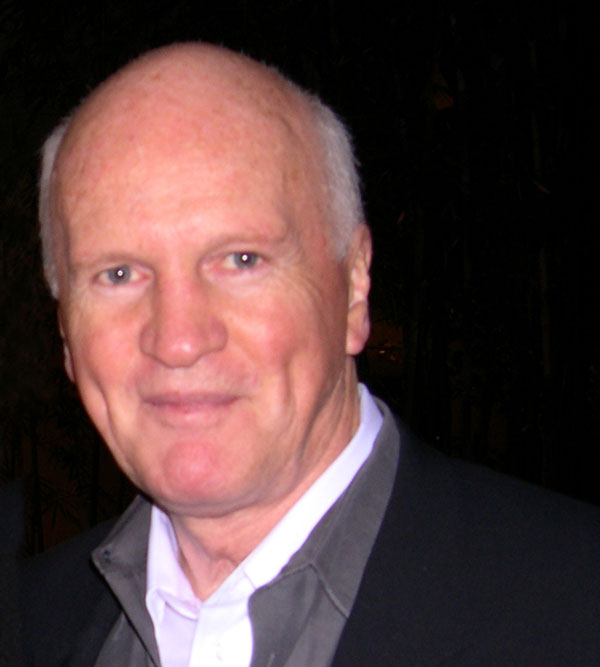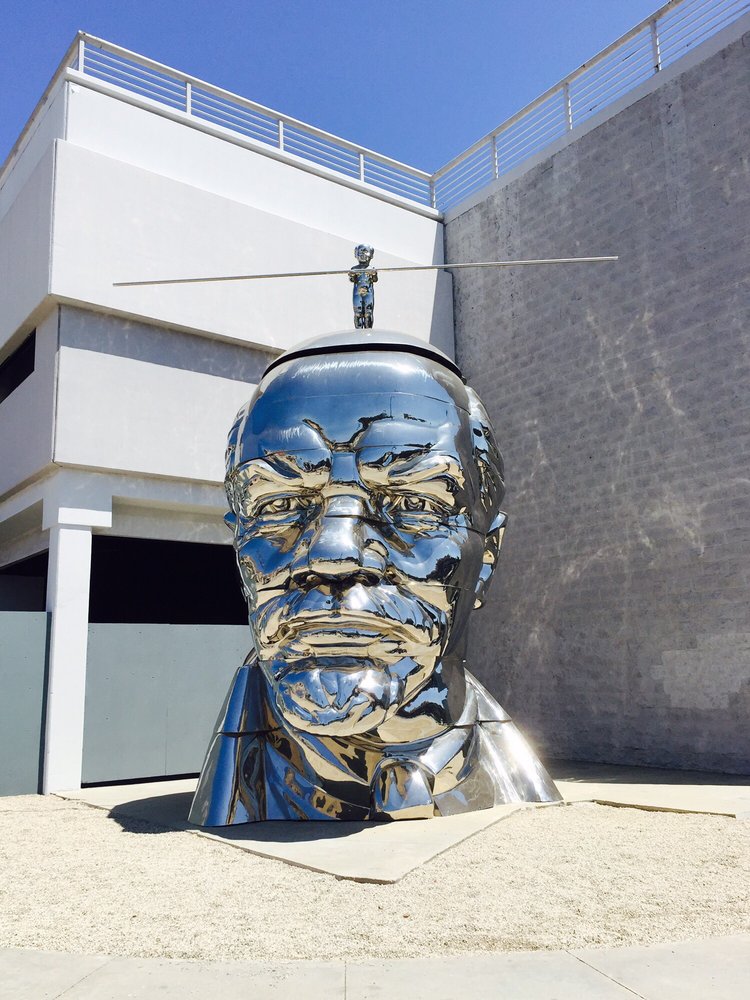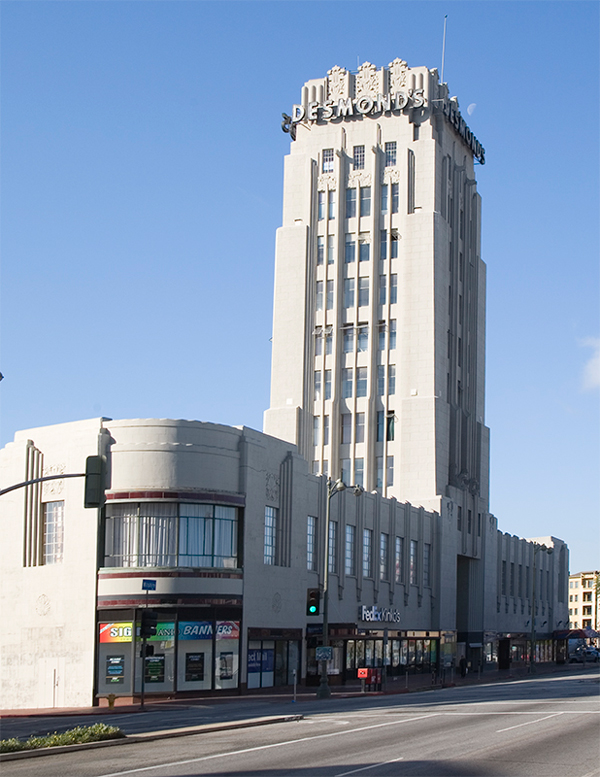Even as the commercial side of the LA art world appears to be reaching historic heights, one of the titans of the local scene has been locked out of his expansive gallery and is being called to account for years of murky management.
Doug Chrismas, the major-domo at Ace Gallery, with super-sized showrooms on Wilshire Boulevard’s Miracle Mile and in Beverly Hills, has for years stayed a step ahead of creditors and disgruntled artists, his trail marked by scores of lawsuits, a criminal pleading and at least five filings for bankruptcy.

Doug Chrismas
Now, however, Chrismas’ creditors appear to have caught up with him at last—or at least to have thrown a net over the art works held by his gallery, and its sales operation. Chrismas has been locked out of his dealership, and the marketing of art works by Ace turned over to an outside manager appointed by the court.
More than that, legal papers filed in connection with the bankruptcy shed new light on the methods used by Chrismas to manage his funds and properties. The maneuvers include dummy corporations, tax dodges and questionable financial transfers. One accountant retained to examine the transactions professed himself “astounded” at the fiscal finagling he found; another ruled some transfers “contrary to tax law.” Separately, a committee of creditors complained that “various fraudulent activities” were diluting their interests.
Reached by phone and asked for comment, Christmas declined to address the bankruptcy proceedings. Instead, he suggested that Artillery hold its story, and said in that case he would speak at length on his circumstances and career. Advised that the article was ready for publication and deadline approaching, Chrismas decided to say no more.
In prior comments to another reporter, Chrismas made light of the installment of a court-appointed manager at Ace, saying he was “thrilled” to be relieved of his management responsibilities. Yet Chrismas resisted the initial inquiries made by Sam Leslie, the practiced court trustee named by the judge to step in as manager at Ace. Within weeks Leslie reached the conclusion that he could not trust Chrismas in business affairs, and obtained authority to change the locks at the gallery and bar Chrismas from the premises. As a consequence Chrismas lost control of artworks that he valued in one recent proceeding at more than $39 million.
: : :
At age 72 Doug Chrismas has been active in the LA art world for half a century. Arriving in Los Angeles from Vancouver in 1966, Chrismas promptly launched Ace and parlayed early, personal relationships with emerging art stars like Robert Rauschenberg and Andy Warhol into success. Over time, he won fame for staging big, ambitious shows, but also notoriety for disputed sales, missing artworks and incessant litigation.
For all the attention Chrismas has drawn, his methods of operation and the extent of his art holdings have remained obscure. That changed when Chrismas filed for bankruptcy protection in February, 2013. Since then his activities have been subject to court review, and recent filings in the case disclose an elaborate financial scheme apparently designed to shield revenues from creditors, and possibly from the IRS. Chrismas used some of the diverted money to pay personal expenses, rent on his penthouse apartment, credit card bills and fees to five different law firms.
Early on in the current bankruptcy proceedings the court directed that Chrismas be left in place to run Ace as a debtor in possession of the business, the better to raise funds, through sales of art, in order to pay his creditors. Over the course of three years in bankruptcy, Ace raised more than $14 million through sales of art. But most of those funds were diverted from the gallery, according to the court-appointed manager; in consequence, as of April 6 Ace was in arrears on rent and payroll, and could not cover its outstanding checks.
The principal dummy company used to divert fees from Ace was an entity called Ace Gallery New York Corporation, formed by Chrismas just days before he filed for bankruptcy protection. A second entity, Ace Gallery New York Inc., was formed around the same time; they appear to have been used interchangeably. The business titles recall a long-defunct gallery Chrismas operated briefly in New York in the 1980s. In this latest incarnation the “Ace Gallery New York” is registered with the CA Secretary of State at the same business address on La Brea Avenue as Ace Los Angeles. It had no separate physical space and no inventory, but was used simply as a shell to broker deals for art originating at the Ace Gallery in Los Angeles.
Chrismas told Sam Leslie this April that he launched Ace New York in order to facilitate sales and raise funds to cover his debts. He needed a new entity to “process [art] sales during the bankruptcy because some people were reluctant to buy art from a company in bankruptcy”—Ace Los Angeles—Chrismas said. After review of documents and ledgers, however, Leslie, a certified accountant, determined the transactions to present “a clear pattern of diversion of money.” As Leslie stated in court papers, “Chrismas used Ace New York to benefit himself… at the expense of the creditors to his estate.”
Timothy Kincaid, an accountant working with Leslie, made a study of the records of art sold through Ace. He found that Chrismas had put art sales by Ace in Los Angeles on the books of Ace New York, but then, rather than return the proceeds to the Los Angeles firm, which then might be subject to the claims of creditors, Chrismas devoted those funds to personal expenses of $391,630 and attorney fees, unrelated to the bankruptcy, of $165,039.

Ace Museum on La Brea Ave.
In addition, Chrismas channeled some of the Ace NY funds over to Ace Museum, a nonprofit entity which Chrismas founded in 2009, housed in a former auto dealership on La Brea Avenue. Ostensibly founded as an institution “to provide art education and to advocate for increasing support for art education,” according to tax filings, Ace Museum has put up only a smattering of exhibitions. It has, however, been the subject of frequent and substantial financial activity, including a founding loan of $4 million from a “current or former officer, director, [or] trustee,” and, more recently, $4.5 million in transfers from Ace Gallery New York.
In conversation with the bankruptcy trustee, Chrismas assured Leslie that operation of the museum would contribute to paying down the Ace debts. “It was unclear exactly how this would be achieved,” Leslie commented in a court filing, “but based on later discussions it appears that Chrismas was seeking to present buyers a proposal whereby they would purchase art from Ace at a reduced price and then immediately donate it to Ace Museum and claim a tax deduction for a much higher value.” Leslie added that, “As a Certified Public Accountant, I know this proposal to be contrary to tax law.”
Nor was the role of Ace NY limited to serving as a simple stand-in for art sales. According to Kincaid, interim loans raised by Chrismas to keep the gallery running while it was in bankruptcy were instead placed with Ace New York. The transfers totaled more than $2.5 million. Some funds were shipped back to Ace in Los Angeles, but most were diverted to other purposes. “In summary,” Kincaid said in court papers, “Ace New York was used as a substitute for Ace by Chrismas and he used it to make payments to third parties for his benefit and to himself that were not permitted to be made.”
: : :
Sam Leslie was directed by Bankruptcy Judge Robert Kwan in March to develop an inventory of the art works owned or controlled by Ace Gallery, to wind down the operations on mid-Wilshire, and if necessary to remove the art works in order to effect sales. Chrismas was ordered to cooperate, and “not to impede” Leslie. Progress thereafter was halting.
In his first of several visits to the gallery, located in the first Art Deco tower built on Wilshire Boulevard, Leslie found art works stored in four different rooms around the main exhibition space. He learned in a later visit of an additional storage room that could be accessed only through Chrismas’s office, which was closed and off-limits. Finally Leslie learned of an off-site storage facility used by Chrismas. When he enquired further regarding this warehouse Leslie “was flatly told that it had nothing to do with Ace and held art work owned by Chrismas personally.”
Leslie requested an inventory of the gallery holdings but was told there was none; he was told Ace relied on “institutional memory” to identify individual pieces and their ownership status. Instead Leslie was given “some lists” designating some works as owned by the gallery and others as loaned on consignment, but the lists covered only about 750 pieces. Leslie’s informal count tallied at least 2,750 works of art on the premises, and Chrismas later informed him the number was “higher than that.”
Based on his review, Leslie found that creating a full inventory of the Ace holdings could cost more than half a million dollars; packing and moving the works could run a million more. Such costs would necessarily be charged before the creditors could be paid.
In the course of subsequent visits to the gallery, Leslie learned from a staffer there that, the day before his initial visit, Chrismas had directed staff to crate up 60 works from the gallery and take them to the offsite warehouse. When Leslie demanded an explanation, Chrismas explained that these works “were his personal pieces” and should not be subject to the claims of Ace creditors. Several of the works had been on hand since at least July of 2015, Leslie learned, but others came to the gallery later. Among the latter group was a work by Robert Rauschenberg.
When Leslie asked Chrismas about the transfers, Chrismas said he’d acquired the works years before, all before the year 2000. Leslie noted in a declaration that none of these artworks had been included among Chrismas assets in a personal bankruptcy he filed in 2004. It was at this point that Leslie decided “I can no longer trust Chrismas,” and told the gallerist he was now barred from the premises at Ace.
: : :
Chrismas has won admiration and notoriety for his wiles in the business of buying and selling art, but he appears to be just as adept in the business of real estate. In fact it was claims from his landlord, and not from his art clients, that prompted Chrismas’ latest bankruptcy.
The current controversy arose in December, 2012, when Chrismas failed to make timely payment for rent due on his mid-Wilshire gallery. The landlord, eager to reclaim control of the property, immediately presented Chrismas with a 10-day notice to quit—the first step toward an eviction. Two weeks later the landlord filed a notice of unlawful detainer, seeking authority to evict. Chrismas paid no rent for the next two months, and on February 9, 2013, filed for bankruptcy.
In his filing Chrismas argued, and the court agreed, that the initial notice to quit was “premature”, thus invalidating both the first notice and the subsequent eviction filing. Ace thus continued its occupancy while seeking to raise funds to pay rent. At the same time, Chrismas sought to exercise an option in the lease that he said authorized him to sell the property, pay the landlord off at $20 million, and keep for himself any surplus, which he estimates to be as much if not more than the base price. That option was contested, however, and the court held for the owners. But Chrismas appealed, thus extending the proceeding.
It was not the first time Chrismas managed to thwart an eviction by filing for bankruptcy. In 2004, after just a year on the Wilshire Blvd. premises, Chrismas missed his September rent payment and was served with a notice to quit the property. In that case Chrismas contested the unlawful detainer in court. When the matter came to trial that December the court found against Chrismas and Ace, but before that judgment was recorded Chrismas filed for bankruptcy. That filing effectively blocked all pending legal action against the plaintiff, including the eviction. Chrismas also took the opportunity to list several major creditors among the debt he sought to discharge, including, principally, more than $2 million in state and federal taxes.
In the meantime Chrismas opened a second gallery, in a large building farther along Wilshire in Beverly Hills. Here, too, Chrismas secured a purchase option, which he exercised in June of last year, selling the Beverly Hills building to the MTA for $40 million. He collected the profits after paying off the original owner, but his proceeds from the sale were sequestered under the bankruptcy proceedings for ultimate payment to Ace creditors.
The 2004 bankruptcy was closed the following year, and Chrismas continued in tenancy at the Wilshire address. When he again missed his rent payment, in 2013, the landlord again moved to evict, and as recounted above, Chrismas again sought protection under the bankruptcy laws.
This most recent filing had a more extensive list of creditors, however—a roster that sheds additional light on Chrismas’ client roster, and his obligations. Among the debtors to be covered and/or discharged in the bankruptcy action are artists Charles Fine, owed $950,000; Gary Lang, owed $700,000; and Mary Corse, awaiting payment of $750,000. Others with lesser claims include Justin Bower, Laurie Lipton, David Amico, Armando Lerma and Carlos Ramirez. That list may yet grow; according to Sam Leslie, since taking over as manager, “I have been inundated by calls from artists whose work is represented by Ace. They are trying to determine if any of their work has been sold, what is still in inventory and what they are owed.”
Further complicating Leslie’s effort to sort out the affairs of Ace Gallery are the claims of several creditors for proceeds of loans to Ace that were collateralized with art works that the gallery never owned. One of those creditors, Westminster Capital, of Beverly Hills, claimed as collateral four paintings by Sam Francis, four by Robert Rauschenberg, and three by Julian Schnabel. Westminster is seeking $500,000 in principal and a like amount in interest.
Still another wrinkle in the current bankruptcy case are claims filed against Ace by Chrismas himself, and by Ace Gallery director Jennifer Kellen. Chrismas claimed to be owed $286,000 in loans made to the gallery, while Kellen is seeking just over a million dollars in commissions and repayment of a loan. The other creditors in the case have challenged the standing of those claims.


